
The longhorn beetles (Cerambycidae), also known as long-horned or longicorns, are a large family of beetles, with over 35,000 species described.

Cerambyx cerdo, commonly known as the great capricorn beetle or cerambyx longicorn, is a species of beetle in family Cerambycidae. It occurs in North Africa, Europe, and Asia.
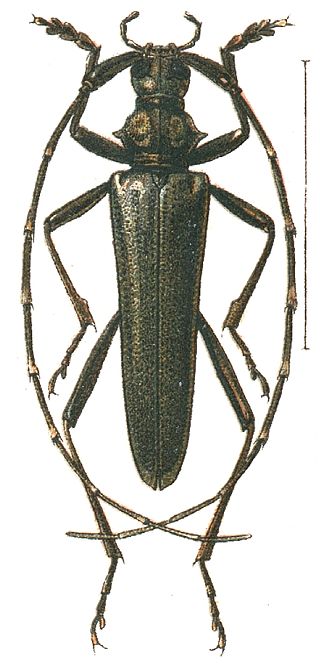
The Disteniidae are a small family of beetles in the superfamily Chrysomeloidea, traditionally treated as a group within the Cerambycidae.
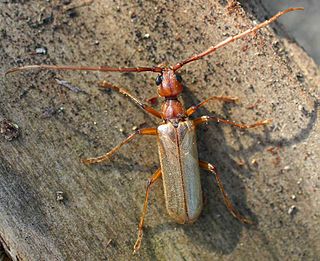
The Vesperidae are a small family of beetles, normally classified within the family Cerambycidae, of heterogeneous aspect but all characterised by larval stages related to roots of herbaceous plants or trees

Lepturinae, the lepturine beetles, is a subfamily of the longhorn beetle family (Cerambycidae), containing about 150 genera worldwide. This lineage is most diverse in the Northern Hemisphere. Until recently the subfamily Necydalinae was included within the lepturines, but this has been recently recognized as a separate subfamily. Nine tribes are usually recognized today, with a tenth, Caraphiini, created in 2016. A few genera are of uncertain placement within the subfamily.

Trichocnemis is a genus of beetles in the longhorn beetle family, Cerambycidae. Its species have often been treated as members of genus Ergates. Authors who separate the two genera differentiate Trichocnemis by a proportionally smaller head, the shape of the mandibles, the length of the antennae, and various other details in the morphology of the body and legs.

Archodontes is a genus of root-boring beetles in the family Cerambycidae. It is monotypic, being represented by the single species Archodontes melanopus. It is endemic to Central America and the south-eastern United States, and bores the roots of oaks and other hardwoods.
Baryssinus huedepohli is a species of longhorn beetle in the family Cerambycidae. It was described by Monné & Martins in 1976. Baryssinus huedepohli is a small to medium-sized beetle, ranging in length from 11 to 17 mm. It is black or brown in color, with white or yellow markings on the head, pronotum, and elytra. The antennae are long and slender, and the legs are relatively short.

Derobrachus megacles is a species of beetle in the family Cerambycidae. It was described by Henry Walter Bates in 1884. It is found in Mexico and Guatemala.
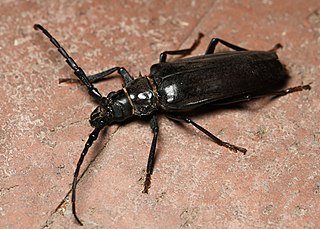
Derobrachus hovorei is a species of beetle in the family Cerambycidae, known variously as the palo verde beetle, palo verde root borer, or palo verde borer beetle. For over 100 years, this species was confused with the related species Derobrachus geminatus, and only recognized and given its own name by Santos-Silva in 2007; essentially all literature prior to 2007 therefore incorrectly uses the name geminatus for this species. It is a longhorn beetle native to the southwestern United States and northern Mexico which derives its common name from the palo verde tree, and it is one of the largest beetles in North America, reaching up to three and a half inches in length. Adults are black or brown in colour, have long antennae, and spines on the thorax. They have wings and can fly, albeit awkwardly at times. Mature beetles emerge in the summer to mate. While not harmful to humans, they can bite in self-defense.
Anisopodus elongatus is a species of beetle in the family Cerambycidae that was described by Henry Walter Bates in 1863.
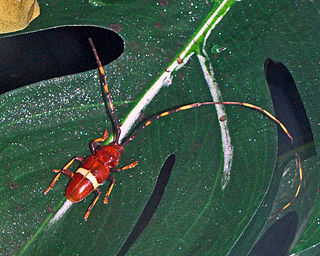
Trachyderes succinctus is a species of beetle in the family Cerambycidae. It was described by Carl Linnaeus in his landmark 1758 10th edition of Systema Naturae.
Amphelictus aibussu is a species of beetle in the family Cerambycidae.
Beraba angusticollis is a species of beetle in the family Cerambycidae. It was described by Zajciw in 1961. The holotype is held in the University of Rio de Janeiro and a photo is available.
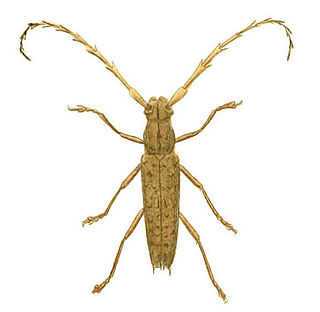
Elaphidion spinicorne is a species of beetle in the family Cerambycidae. It was described by Dru Drury in 1773 from Jamaica.
Praxithea javetii is a species of beetle in the family Cerambycidae. It was described by Chabrillac in 1857. The holotypes were collected in Brazil.
Otteissa sericea is a species of beetle in the family Cerambycidae, and the only species in the genus Otteissa. It was described by Pascoe in 1864. It can be found in South Africa.
Afroartelida quentini is a species of longhorn beetle in the family Cerambycidae found in Malawi. It was described by Vives in 2011.

Onychocerus albitarsis is a relatively rare species of beetle in the family Cerambycidae from the Amazon and Atlantic forest regions in Brazil, Bolivia, Paraguay and southern Peru. It is remarkable for being the only known beetle that has a venomous sting and the only known arthropod that stings with its antennae. Each antenna ends in a stinger that has evolved to resemble a scorpion's tail and it is connected to a venom gland. The sting was already reported in 1884 but researchers thought the pain only was caused by the sharpness of the antennae, as also known from some other beetles. It was only confirmed in 2005 that it is venomous when a biologist was stung, comparing it to a bee sting, and subsequently studied it in detail. In the first of two other cases where the identity of the stinging insect was confirmed to be this beetle, a woman experienced significant pain directly after the incident, and redness and itching at the sting site that lasted for a week. In the other case a man experienced moderate pain directly after being stung and redness that only lasted for an hour. The other species in the genus Onychocerus appear to not be venomous since they lack the structures inside the antennae that are associated with the venom apparatus of Onychocerus albitarsis.
Parmenolamia unifasciata is a species of beetle in the family Cerambycidae, and the only species in the genus Parmenolamia. It was described by Stephan von Breuning in 1950, from a specimen collected in Quang Tre Vietnam.











